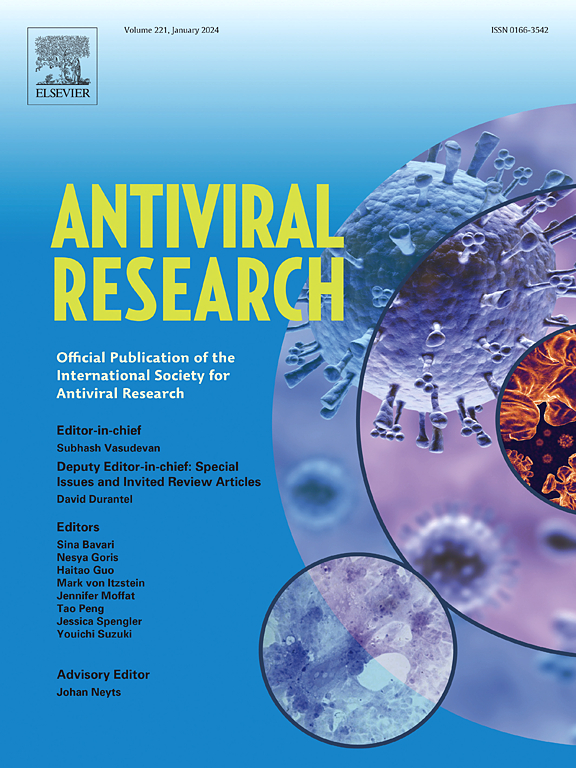在HBeAg阳性CHB患者抗病毒治疗期间,血清o -糖化HBsAg水平与HBV RNA相关。
IF 4.5
2区 医学
Q1 PHARMACOLOGY & PHARMACY
引用次数: 0
摘要
背景:最近的证据表明,中间HBsAg的o糖基化PreS2结构域是识别HBV Dane颗粒和svp的HBsAg的一个显著特征。本研究的目的是评估接受ETV或Peg-IFNα治疗的CHB患者血清o -糖化HBsAg水平的变化。方法:回顾性研究纳入86例基因型CHB患者。我们在基线和ETV或Peg-IFNα治疗期间测定了o糖基化HBsAg、HBsAg、HBeAg、HBV DNA和HBV RNA。o -糖基化HBsAg与常规HBV标志物水平的相关性也被检查。此外,我们进行了ROC分析,以评估个体生物标志物对病毒学反应的预测价值。结果:基线时,HBeAg阳性患者血清o -糖基化HBsAg水平与HBsAg (r=0.754)、HBV DNA (r=0.498)、HBeAg (r=0.404)、HBV RNA (r=0.399)呈显著相关。抗病毒治疗后o -糖化HBsAg下降。基线时,0 -糖基化HBsAg和HBsAg与血清HBV DNA和HBV RNA均有显著相关性,而在DNA检测不出的患者接受ETV治疗后,只有o -糖基化HBsAg仍与HBV RNA相关(r=0.397)。在Peg-IFNα治疗后dna检测不出的患者中,o -糖基化HBsAg与HBV RNA的相关性(r=0.846)显著高于HBsAg (r=0.800)。结论:HBeAg阳性基因型C患者在抗病毒治疗期间血清o -糖基化HBsAg水平下降,且与常规HBV标志物相关性良好,提示其可能是HBV dna抑制患者潜在的监测生物标志物。本文章由计算机程序翻译,如有差异,请以英文原文为准。
Serum O-glycosylated HBsAg levels correlate with HBV RNA in HBeAg positive CHB patients during antiviral therapy
Background
Recent evidence has indicated that the O-glycosylated PreS2 domain of the middle HBsAg is a distinguishing characteristic that allows the identification of HBsAg of HBV Dane particles and SVPs. This study's objective was to assess the changes in serum O-glycosylated HBsAg levels in CHB patients undergoing ETV or Peg-IFNα treatment.
Methods
Our retrospective study enrolled 86 patients with genotype C CHB. We determined the O-glycosylated HBsAg, HBsAg, HBeAg, HBV DNA, and HBV RNA at baseline and during ETV or Peg-IFNα treatment. The correlations between O-glycosylated HBsAg and conventional HBV marker levels were also examined. Furthermore, we performed a ROC analysis to evaluate the predictive value of individual biomarkers for virological response.
Results
At baseline, the serum O-glycosylated HBsAg levels were significantly correlated with the HBsAg (r = 0.754), HBV DNA (r = 0.498), HBeAg (r = 0.404), and HBV RNA (r = 0.399) in HBeAg positive patients. O-glycosylated HBsAg decreased after antiviral therapy. Both O-glycosylated HBsAg and HBsAg were significantly correlated with serum HBV DNA as well as HBV RNA at baseline, while only O-glycosylated HBsAg still correlated with HBV RNA (r = 0.397) in DNA-undetectable patients after ETV therapy. O-glycosylated HBsAg was significantly correlated with HBV RNA (r = 0.846) in DNA-undetectable patients after Peg-IFNα therapy compared to that of HBsAg (r = 0.800).
Conclusion
Serum O-glycosylated HBsAg level decreased during anti-viral therapy and correlated well with conventional HBV markers in HBeAg positive genotype C patients, suggesting that it could be a potential monitoring biomarker in HBV DNA-suppressed patients.
求助全文
通过发布文献求助,成功后即可免费获取论文全文。
去求助
来源期刊

Antiviral research
医学-病毒学
CiteScore
17.10
自引率
3.90%
发文量
157
审稿时长
34 days
期刊介绍:
Antiviral Research is a journal that focuses on various aspects of controlling viral infections in both humans and animals. It is a platform for publishing research reports, short communications, review articles, and commentaries. The journal covers a wide range of topics including antiviral drugs, antibodies, and host-response modifiers. These topics encompass their synthesis, in vitro and in vivo testing, as well as mechanisms of action. Additionally, the journal also publishes studies on the development of new or improved vaccines against viral infections in humans. It delves into assessing the safety of drugs and vaccines, tracking the evolution of drug or vaccine-resistant viruses, and developing effective countermeasures. Another area of interest includes the identification and validation of new drug targets. The journal further explores laboratory animal models of viral diseases, investigates the pathogenesis of viral diseases, and examines the mechanisms by which viruses avoid host immune responses.
 求助内容:
求助内容: 应助结果提醒方式:
应助结果提醒方式:


